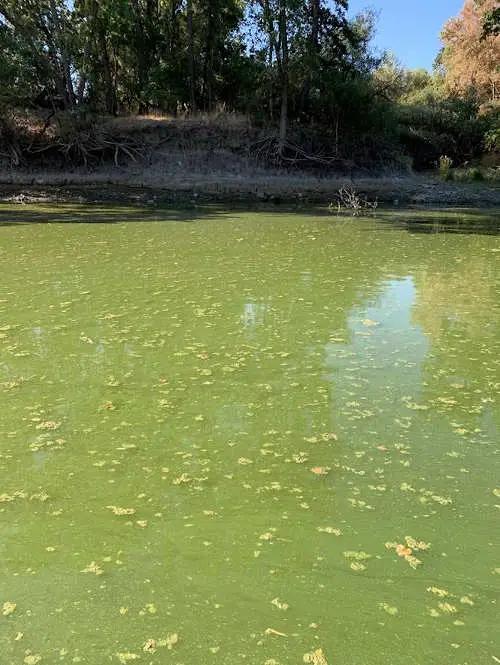
LAKE COUNTY, Calif. — Lake County Public Health on Thursday offered more information as well as clarification on an urgent advisory issued the previous night regarding drinking water taken from Clear Lake through private intakes.
On Wednesday night, Public Health Officer Dr. Gary Pace issued the following statement: “Effective immediately, people on private water systems whose tap water comes from their own private intake into the lake, in the Oaks Arm and Lower Arm of Clear Lake should not drink the water. Very high levels of cyanotoxin have been identified in these areas of the lake, and we are concerned there may be health impacts if private water systems are not effectively filtering out these toxins.”
On Thursday, Lake County Special Districts Administration, the drinking water provider for many Lake County residents, offered clarification on the advisory.
“This does not apply to public [or large privately-owned and professionally managed] water systems using Clear Lake as a raw water source,” Special Districts said.
“Public Water Systems have multifaceted treatment processes in place to effectively treat for cyanotoxins and provide safe water for consumption and use. Additionally, all 18 public water systems on the lake regularly test the raw and treated water for Microcystins and report to the State Water Resources Control Board, Division of Drinking Water,” the agency said.
Special Districts urged community members to contact their public water systems if they wanted more information on those test results.
Big Valley Band of Pomo Indians’ Environmental Protection Department recently sampled 50 of the 280 private systems that are drawing water directly from the lake in the Oaks and Lower Arms of Clear Lake. Participation was voluntary.
Ninety percent of tested tap water from those that participated showed amounts of cyanotoxin above the safe drinking water level advised by the U.S. Environmental Protection Agency.
This was before the recent very significant rise in toxins, so cyanotoxin levels in these private systems are likely much higher now, officials said.
The county said there is no easy fix if you are getting your water in this way; boiling or putting chemicals in the lake or tap water does not eliminate the toxins.
Many county residents have shared questions and concerns, here are some answers to frequently asked questions.

Who is affected by the health advisory?
If you live in the Oaks or Lower Arms of Clear Lake and you do not receive a regular water bill from a public water system, the advisory to avoid drinking tap water very likely applies to you.
If you are on a public water system, your tap water goes through a multifaceted treatment process, and testing to date has shown it is safe to drink; contact your water provider with specific questions.
If you are outside of the areas of the Oaks and Lower Arms, and you have a private intake that draws water directly from Clear Lake, the current advisory does not apply to you.
However, it is prudent to follow current water quality conditions at the Clear Lake Water Quality Facebook page or the Big Valley Rancheria cyanotoxins testing webpage.
How long will this advisory last?
Due to current conditions, the advisory may go on for weeks. Lake water is tested every two weeks (next sampling will be conducted Sept. 21, but it takes time to get the results. The county will inform people when test results show safer levels of cyanotoxins.
What uses of affected tap water should I avoid?
Do not drink or cook with water that contains high levels of cyanotoxins. Boiling the water does not help, nor does adding anything to your tap water. Please do not add any chemicals or other treatment to Clear Lake.
Showering with affected water is thought to be okay, as long as none is swallowed (ingested). Cyanotoxins can be more dangerous for children under six years of age, so please educate and monitor your young children to not swallow any tap water.
Even lower levels of toxins can cause harm to pets; it is strongly recommended to keep pets out of and away from lake water in the Oaks and Lower Arms of Clear Lake. Do not allow pets to drink water directly from Clear Lake, especially where cyanotoxins are known to be present.
Is my private (groundwater) well impacted by these toxins?
So far, no sampled wells, even when located close to the lake, have tested positive for cyanotoxins. Well water is cool and dark, not the ideal habitat for toxin-producing cyanobacteria and they are unlikely to grow in wells.
Do you believe you or a family member may have ingested water affected by cyanotoxins?
Please report it at https://mywaterquality.ca.gov/habs/do/bloomreport.html. You should also call Public Health, 707-263-1164, for guidance. If you are experiencing significant symptoms, seek medical care.
How can I access more usable drinking water?
Alternative filling stations are being established for the homes (280, in total) affected by this Water Advisory. Affected property owners will be informed of available alternatives, as they are established.
Why are we seeing such high levels of cyanotoxins?
Recent high cyanotoxin levels are believed to be related to persistent heat and low water levels due to the drought.
How do harmful algal blooms affect recreation on Clear Lake?
Recommendations differ based on the level of toxins present. Maps produced by Big Valley Rancheria use arrows mirroring the colors associated with different levels of concern.
At any given time, there are many areas of Clear Lake that are safe to use for swimming and other recreational purposes.
Helpful Spanish and English language graphics can be found here.


 How to resolve AdBlock issue?
How to resolve AdBlock issue? 





